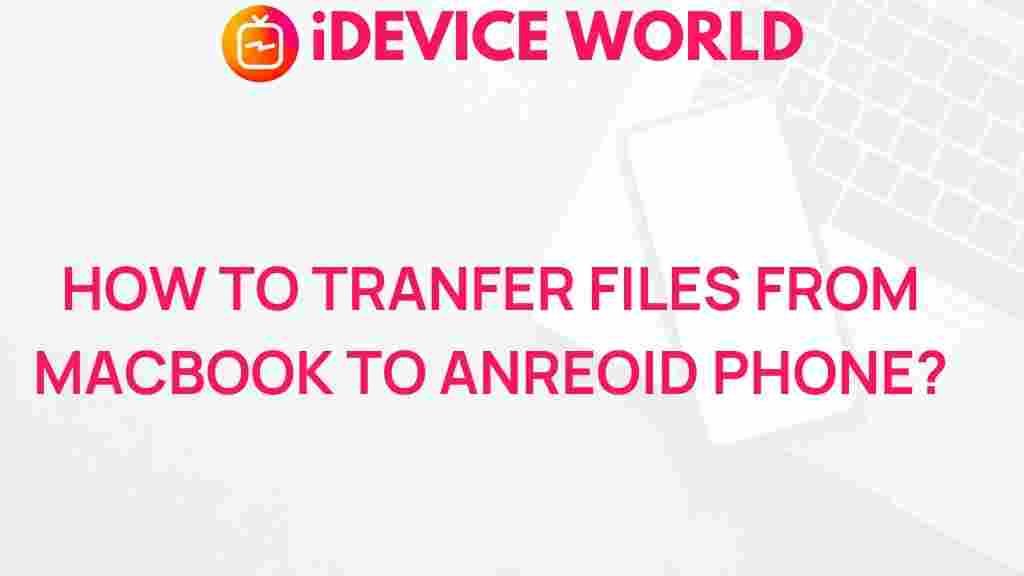File Transfer: Unlocking the Secrets of Transferring Files from MacBook to Android Phone
Transferring files from a MacBook to an Android phone can seem daunting, but with the right methods and tools, it becomes a seamless process. Whether you want to share photos, documents, or music, understanding the various ways to facilitate a smooth file transfer can enhance your productivity and convenience. In this article, we will delve into the methods, tools, and tips necessary for successfully moving files from your MacBook to your Android device.
Why Transfer Files from MacBook to Android Phone?
There are several reasons why you might want to transfer files from your MacBook to your Android phone:
- Convenience: Access your important files on-the-go.
- Backup: Keep your files safe by having copies on multiple devices.
- Sharing: Easily share documents and media with friends or colleagues.
- Organization: Maintain a clutter-free workspace on your MacBook.
Methods for Transferring Files
Here are some effective methods to transfer files from your MacBook to your Android phone:
1. Using Android File Transfer
Android File Transfer is an official tool from Google that facilitates the file transfer process between Mac and Android devices. Here’s how to use it:
- Download and Install: Download Android File Transfer from the official website. Follow the installation instructions.
- Connect Your Devices: Use a USB cable to connect your Android phone to your MacBook.
- Open Android File Transfer: The application should launch automatically. If not, open it manually from your Applications folder.
- Transfer Files: Navigate through your MacBook’s folders, select the files you wish to transfer, and drag them into the Android File Transfer window.
2. Using Bluetooth
If you prefer a wireless method, Bluetooth is a convenient option. Here’s how to transfer files using Bluetooth:
- Enable Bluetooth: On your Android phone, go to Settings > Bluetooth, and turn it on. On your MacBook, click the Bluetooth icon in the menu bar and select “Turn Bluetooth On.”
- Pair Devices: Ensure both devices are discoverable. Select your Android device from the list on your MacBook to initiate pairing.
- Select Files: On your MacBook, right-click on the file you want to send, choose “Share,” then select “Bluetooth.”
- Receive Files: Accept the incoming file transfer on your Android phone when prompted.
3. Using Cloud Storage Services
Cloud storage solutions such as Google Drive or Dropbox make file transfers easy and accessible. Here’s how:
- Upload Files: On your MacBook, upload the files you want to transfer to a cloud storage service.
- Access on Android: Open the corresponding app on your Android device and download the files you need.
4. Using Third-Party Applications
Several third-party applications can simplify the file transfer process. Here are a couple of popular options:
- SHAREit: A fast and user-friendly app for transferring files without a USB cable.
- Pushbullet: Useful for sending files and links between devices instantly.
Troubleshooting Common Issues
While transferring files can be straightforward, you may encounter some issues. Here are common problems and their solutions:
- Device Not Recognized: Ensure the USB cable is functioning and the devices are properly connected.
- Slow Transfer Speeds: For Bluetooth transfers, ensure that both devices are close together and that there are no obstructions.
- File Type Compatibility: Some files may not transfer due to compatibility issues. Check the supported file types on your Android device.
Best Practices for File Transfer
To ensure a smooth and efficient file transfer experience, consider the following tips:
- Keep Software Updated: Ensure both your MacBook and Android phone are running the latest software updates.
- Organize Files: Before transferring, organize files on your MacBook to make it easier to find them later on your Android device.
- Use Reliable Applications: Stick to trusted apps and tools to avoid security risks.
Conclusion
Transferring files from a MacBook to an Android phone can be simple and efficient with the right methods. Whether you choose to use Android File Transfer, Bluetooth, cloud services, or third-party apps, the key is to find a method that suits your needs best. By following the steps outlined in this guide, you can successfully move files between devices, ensuring your important data is always accessible. Remember to troubleshoot common issues and adhere to best practices for the best experience. For more information on file management and sharing, check out this resource.
This article is in the category Guides & Tutorials and created by iDeciveWorld Team
